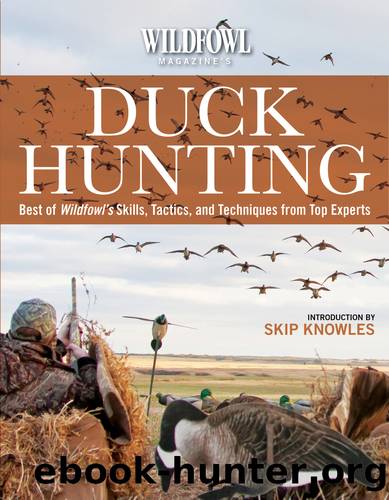Wildfowl Magazine's Duck Hunting by Skip Knowles

Author:Skip Knowles
Language: eng
Format: epub
Publisher: Skyhorse
Published: 2017-06-14T16:00:00+00:00
Hansen Broadbill, the Dan Brown handmade, and a Red Duck
Another historic call was the metal-reed Reelfoot-style call. As much as these large metal-reed calls are associated with northwest Tennessee and the great duck-hunting culture of Reelfoot Lake, they actually originated in Illinois. Victor Glodo was born and raised in southwestern Illinois near Grand Tower. He was a jack of all trades: carpentry, blacksmithing, market hunting and making duck calls. When the area around Grand Tower was drained for farming, Glodo and wife Vada moved to Starve Island on Reelfoot Lake. Glodo’s calls were all hand-made with little machining involved. They constituted a large wooden barrel into which set a flat tone board with a curved metal reed held in place with a wooden wedge that sealed the call. Glodo’s calls were frequently checkered with a wide skip-line pattern, and have become the basis for all metal-reed calls. Others like John “Sundown” Cochran, John “Son of Sundown” Cochran, Earl Dennison and Johnny Marsh continued Glodo’s legacy, and today there are numerous custom callmakers and descendants of these early callmakers dedicated to crafting metal-reeds.
Hunting on Reelfoot is extremely competitive with numerous blinds vying for high-flying flocks of mallards, hence the long, high-pitched “Reelfoot highballs” and other calls that use the metal-reed calls to their maximum. Reelfoot guides can really scream on these metal-reed calls. Callmaker Greg Hood once said, “Those ducks can see everything up there. The first one to attract their attention has the best chance of getting them in.”
STAGE PRESENCE
Contests have done more to raise the level of calls and calling than any other activity. At one time, fine mallard calls came almost exclusively from the Stuttgart area, and good metal-reed calls came from northwest Tennessee around Reelfoot. In the 1980s, word began to spread, and a surge in callmakers and good calling resulted.
The goal, of course, is the Main-Street stage in Stuttgart where on the Saturday following Thanksgiving, the World’s Duck Calling Championship is contested. The first was in 1936 with a $6 hunting coat as the prize. Early winners were from along the Mississippi from Louisiana to Illinois and Iowa. The first man to win was Thomas E. Walsh of Greenville, Miss., who called “by mouth” making all the duck sounds vocally. Normally thought to be a “man’s contest,” Pat Peacock Johnson, renowned callmaker D. M. “Chick” Major’s step daughter, won the World in both 1955 and ’56. In those days competitors used wooden calls, often their hunting call, but today callers compete with acrylics capable of drowning out a 747 at takeoff.
Duck calling is a unique American folk art form of both the calls and hunters using them to lure ducks to their decoys. In South America, guides use calls that at best make a dusky quack, relying instead on whistles made from wood or the heads of spent shotgun shells. In Europe calls are sold in gun shops, but mostly as a novelty. Here in the U.S., we are deadly serious about our calling, as it should be.
Download
This site does not store any files on its server. We only index and link to content provided by other sites. Please contact the content providers to delete copyright contents if any and email us, we'll remove relevant links or contents immediately.
Sapiens: A Brief History of Humankind by Yuval Noah Harari(13036)
The Tidewater Tales by John Barth(12025)
Do No Harm Stories of Life, Death and Brain Surgery by Henry Marsh(6332)
Mastermind: How to Think Like Sherlock Holmes by Maria Konnikova(6224)
The Thirst by Nesbo Jo(5778)
Why We Sleep: Unlocking the Power of Sleep and Dreams by Matthew Walker(5636)
Sapiens by Yuval Noah Harari(4528)
Life 3.0: Being Human in the Age of Artificial Intelligence by Tegmark Max(4492)
The Longevity Diet by Valter Longo(4443)
The Rules Do Not Apply by Ariel Levy(3897)
The Immortal Life of Henrietta Lacks by Rebecca Skloot(3820)
The Body: A Guide for Occupants by Bill Bryson(3789)
Why We Sleep by Matthew Walker(3767)
Animal Frequency by Melissa Alvarez(3750)
Yoga Anatomy by Kaminoff Leslie(3696)
Barron's AP Biology by Goldberg M.S. Deborah T(3628)
The Hacking of the American Mind by Robert H. Lustig(3575)
All Creatures Great and Small by James Herriot(3506)
Yoga Anatomy by Leslie Kaminoff & Amy Matthews(3392)
